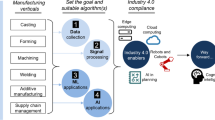Abstract
This paper develops a mathematical model for designing cells which can handle time-varying part demands. This is primarily carried out by simultaneously identifying cells and part production plans. Given the computational complexity of the model, we first evaluate the efficacy of several alternative lower bounding methods. Based on these methods, we develop multiple heuristic procedures and evaluate them using published and industry data. The results indicate that a lower bounding scheme using valid inequalities provides strong lower bounds for our model and that the heuristic provides solutions which are near-optimal.
Similar content being viewed by others
References
R.G. Askin, H. Selim and A.J. Vakharia, A methodology for designing flexible cellular manufacturing systems, IIE Transactions 29(1997)599 - 610.
R.G. Askin and S.P. Subramanian, A cost-based heuristic for Group Technology configuration, International Journal of Production Research 25(1987)101 - 113.
J.L. Burbidge, The Introduction of Group Technology, Wiley, New York, 1975.
A.S. Carrie, Numerical taxonomy applied to Group Technology and plant layout, International Journal of Production Research 11(1973)399- 416.
M.P. Chandrasekharan and R. Rajagopalan, An ideal seed non-hierarchical clustering algorithm for cellular manufacturing, International Journal of Production Research 24(1986)451- 464.
M.P. Chandrasekharan and R. Rajagopalan, ZODIAC - an algorithm for concurrent formation of part-families and machine-cells, International Journal of Production Research 25(1987)835 - 850.
N.E. Dahel and S.B. Smith, Designing flexibility into cellular manufacturing systems, International Journal of Production Research 31(1993)933 - 945.
J. De Witte, The use of similarity coefficients in production analysis, International Journal of Production Research 18(1980)503 - 514.
A. Kusiak, The generalized Group Technology concept, International Journal of Production Research 25(1987)561 - 569.
R. Logendran, A workload based model for minimizing total intercell and intracell moves in cellular manufacturing, International Journal of Production Research 28(1990)913 - 925.
R. Logendran, A binary integer programming approach for simultaneous machine - part grouping in cellular manufacturing systems, Computers and Industrial Engineering 24(1993)329- 336.
J. McAuley, Machine grouping for efficient production, The Production Engineer 51(1972)53.
S. Sankaran and R.G. Kasilingam, On cell size and machine requirements planning in Group Technology systems, European Journal of Operational Research 69(1993)373 - 383.
J.E. Schaller, Configuring cell systems to handle variable demand, Unpublished Ph.D. Dissertation, University of Florida, 1996.
H. Seifoddini, Duplication process in machine cell formation in Group Technology, IIE Transactions 21(1989)382 - 388.
H. Selim, R.G. Askin and A.J. Vakharia, Cell formation in Group Technology: Review evaluation and directions for future research, Computers and Industrial Engineering (1997).
N. Singh, Design of cellular manufacturing systems: An invited review, European Journal of Operational Research 69(1993)284–291.
G. Srinivasan, T.T. Narendran and B. Mahaderan, An assignment model for the part-families problem in Group Technology, International Journal of Production Research 28(1990)145 - 152.
L.E. Stanfel, Machine clustering for economic production, Engineering Costs and Production Economics 9(1985)73 - 81.
A.J. Vakharia and B.K. Kaku, Redesigning a cellular manufacturing system to handle long-term demand changes: Methodology and investigation, Decision Sciences 24(1993)909 - 930.
A.J. Vakharia and H.M. Selim, Group Technology, in: The Handbook of Design, Manufacturing, and Automation, R.C. Dorf and A. Kusiak, eds., Wiley, New York, 1994, pp. 435 - 460.
J.C. Wei and N. Gaither, An optimal model for cell formation decisions, Decision Sciences 21 (1990)416 - 433.
U. Wemmerlöv and N.L. Hyer, Procedures for the part family/machine group identification problem in cellular manufacturing, Journal of Operations Management 6(1986)125 - 147.
U. Wemmerlöv and N.L. Hyer, Group Technology in the US manufacturing industry: A survey of current practices, International Journal of Production Research 27(1989)1287 - 1304.
Rights and permissions
About this article
Cite this article
Schaller, J.E., Selçuk Erengüç, S. & Vakharia, A.J. A methodology for integrating cell formation and production planning in cellular manufacturing. Annals of Operations Research 77, 1–21 (1998). https://doi.org/10.1023/A:1018965025510
Issue Date:
DOI: https://doi.org/10.1023/A:1018965025510




